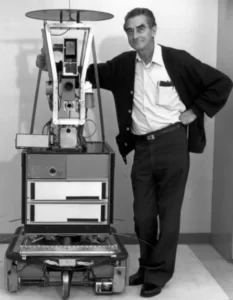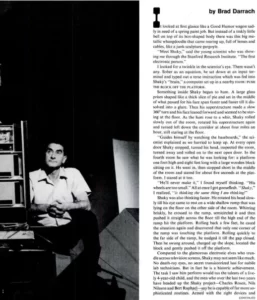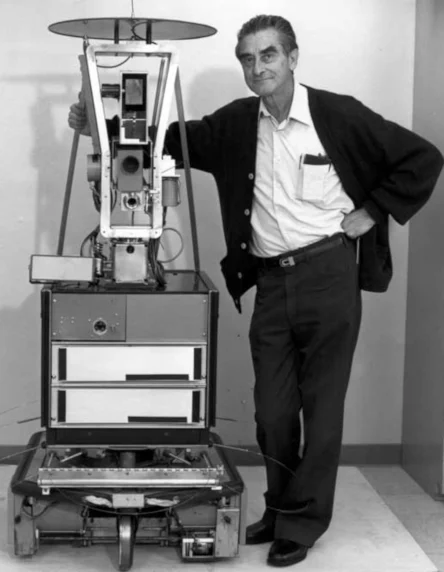Key Points:
- Shakey the Robot, built in the 1960s, was the first mobile robot able to perceive and reason about its surroundings.
- This early robot became an archetype from which subsequent robots were built and significantly influenced modern robotics and AI techniques.
- When Shakey the Robot was covered in the 20 Nov 1970 edition of Life Magazine, the machine was referred to as “the first electronic person.”
Artificial Intelligence has come a long way and achieved significant milestones over the years. The history of AI and machine learning cannot be discussed without mentioning Shakey the Robot. Created in the late 1960s, Shakey was the first mobile robot with the ability to perceive and reason about its surroundings. Its developers were a group of engineers at Stanford Research Institute (SRI) managed by Charles Rosen, and the project was funded by the Defense Advanced Research Projects Agency (DARPA).

5 Facts about Shakey the Robot
- Shakey obtained its name from the way it could shake when it came to an abrupt stop. This was after a month of its creators trying to find a suitable name for the machine.
- Shakey used the Lisp programming language2, as well as FORTRAN, and responded to simple English-language commands.
- Shakey was envisioned as an experimental platform for integrating computer vision, navigation, autonomous plan creation, logical reasoning, and machine learning.
- It laid a layered architectural model in which subsequent robots were built and significantly influenced modern robotics and AI techniques
- Shaky could understand about 100 words of written English, translate these words into a simple verbal code, and then translate the code into the mathematical formulas in which his actual thinking is done.
Shakey the Robot: History
Shakey came into existence in the late 1960s. Charles Rosen, Peter Hart, and Nil Nilsson were the project managers who steered the team that developed it.
Quick Facts
- Created
- 1960
- Creator (person)
- Charles Rosen, Nils Nilsson, Bert Raphael
- Original Use
- Perform tasks that required planning, route-finding, and the rearranging of simple objects
In November 1963, Charles Rosen, who had founded the Machine Learning Group at SRI, dreamed up the world’s first mobile automaton. In the following year, Rosen proposed building a robot that could think for itself, but his idea was met with skepticism by many in the nascent AI field. In the same year, Rosen applied for funding from DARPA, which grants funds for the development of emerging technologies. It took Rosen two years to get the financing (DARPA granted the researchers $750000—more than $5 million in today’s money), and it took six more years, until 1972, before engineers at SRI’s AI Center finished building Shakey.
The nature of the project required a combination of computer vision, research in robotics as well as natural language processing. This made it the first project that merged logical reasoning and physical action. Shakey’s programming was primarily done in Lisp — one of the earliest programming languages.
Shakey the Robot: How it Worked
Shakey was a little less than two meters tall and had three sections. At the bottom was a wheeled platform (two stepping motors, one connected to each of the side-mounted drive wheels) that gave the robot its mobility and collision detection sensors. Atop those looked like three slide-in units in a rack: those held the robot’s camera control unit and the onboard logic. Stacked on the uppermost unit were a range finder, a TV camera, and a radio antenna protruding from the top.

A radio link connected Shakey to a computer, which could process the incoming data and send commands to the circuits that controlled the robot’s motors. Initially, an SDS (Scientific Data Systems) 940 computer was used. Around 1969, a more powerful DEC PDP-10 replaced the SDS 940. The PDP-10 used a large magnetic drum memory (the size of a refrigerator, holding some 1 megabyte) for swapping time-shared jobs in and out of working core memory.
Shakey used the Lisp programming language, as well as FORTRAN, and responded to simple English-language commands. A command to roll 2.1 feet would look like this:
SHAKEY = (ROLL 2.1)
Other commands included TILT, PAN, but there were also GOTO statements (which instead of jumping to a new position in the code) would actually cause Shakey to go to a new position in the real world.
SHAKEY = (GOTO D4)
Which is more important, Shakey itself would first plan out the route it was going to take, even plotting a course around obstacles. And it could perform other useful tasks, like moving boxes.
SHAKEY = (PUSH BOX1 = (14.1, 22.7))
The main planning component for its software was the Stanford Research Institute Problem Solver (STRIPs) planner. Shaky operated in a limited world, which contained rooms connected with corridors and light switches for the robot to operate.
The planner would devise a plan to enact actions such as opening and closing doors, turning lights on and off, and pushing movable objects. Whenever an operator typed a command like “push the block off the platform,” it would initiate Shakey’s mission. Shakey would search around for a platform with a block on it. Upon identifying the platform, he would locate a ramp to help reach the platform, roll it over the platform, charge up the slope, locate the block, and gently push it off the platform.
Shakey the Robot: Historical Significance
Shakey was a historic achievement. According to the project leads — Charles Rosen, Nils Nilsson, and Bert Raphael — armed with the proper devices, Shakey was capable of far more sophisticated routines. When presenting Shakey in an extensive article in Life Magazine of 20 Nov 1970, a young scientist introduced it as “The first electronic person.”

Shakey’s brain defied the conventional views that the computer cannot challenge the human monopoly of reason and demonstrated that machines could think. Shakey served as an existence proof that encouraged later developers to develop more advanced robots. Its development significantly impacted the fields of robotics, artificial intelligence, and computer science in general. As a result, A* search algorithm—widely used in pathfinding and plotting an efficiently traversable path between points was developed.
Other developments include the Hough transform — a technique used in image analysis, digital image processing, computer vision, and the visibility graph method for finding Euclidean shortest paths among objects. Its unique combination of AI and robotics into one system had a significant historical significance.
Also, technologies such as cell phones, global positioning systems (GPS), the Roomba, and self-driving vehicles have become a reality and simplified life thanks to the inspiration of Shakey.

